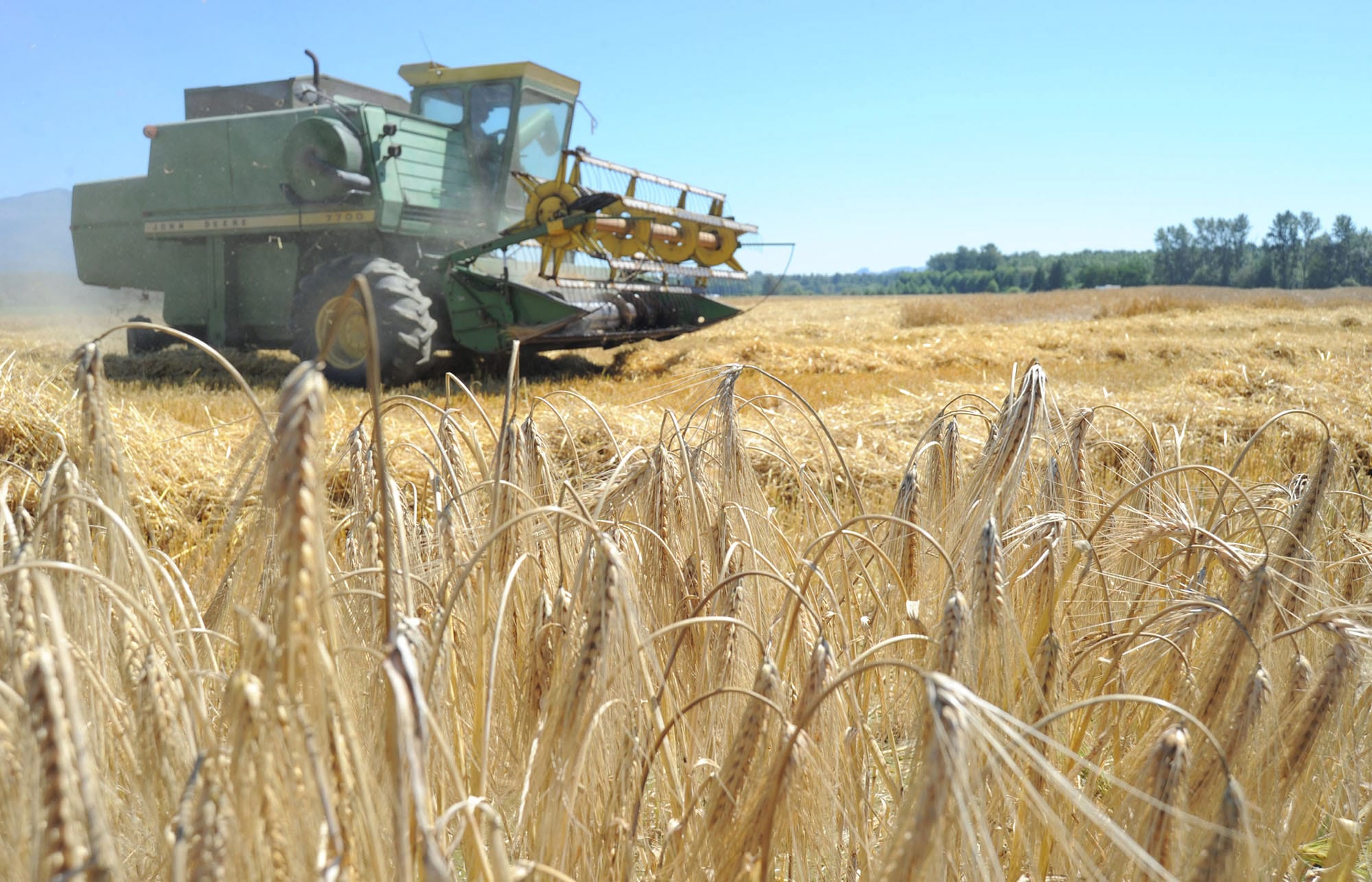BURLINGTON — Four years after embarking on a mission to raise the value of locally grown grain, the team at Skagit Valley Malting Co. is nearly ready to move into production.
The enterprise is aiming to introduce regional brewers, distillers and bakers to a wide variety of specialty malts, multiplying flavor profiles available in beer and whiskey.
Malt users from around the region and across the country are lining up to experiment with some of the company’s first products.
Recently harvested from local fields, 300 tons of locally grown winter barley has been harvested and is drying in two new 230-ton dryers in the Bayview Business Park, waiting to be fine-sorted and cleaned for the first 12,000-pound batches of malt.
The last pieces for the company’s first production malting machine came in last Sunday and will be assembled immediately, said founder Wayne Carpenter, and the first batches of finished malt should be sold by November.
Carpenter likened brewers’ current selection of domestically produced malted barley to the culinary choices available to a chef who could only cook steak.
“You can change the way you cook it. With malt that would be like the 155 different roasts you can use for barley. You can change the spices you use — in brewing that would be hops — but it’s still steak,” Carpenter said. “We want to introduce pork, turkey, even fish.”
Carpenter said the malting machines designed and built by his company are relatively small for the industry, as are the dryers.
The malting machines use computers and proprietary software and hardware to control the complex processes (up to 250 steps for some grains) that wash, soak, germinate, dry and roast grains.
Large malting companies in the United States currently produce malt from eight to 10 varieties of barley that are similar to each other in flavor, Carpenter said.
With flexible machines, Carpenter said malt from approximately 10,000 different varieties of barley and 40,000 varieties of wheat being tested by Washington State University in Mount Vernon could be made available to brewers, distillers and bakers.
Carpenter said four varieties of barley will be harvested this year from 40- to 100-acre plots for production. He said 11 others are in three- to five-acre test plots, which will be malted, then tested by brewers and distillers for quality.
An additional 30 varieties targeted for malting characteristics are currently undergoing testing by the WSU research center to see how well they grow in Skagit County, Carpenter said.
Matt Hofmann, master distiller for Westland Distillery in Seattle, said his company worked with WSU researchers and Skagit Valley Malting’s crew to help identify desirable barley characteristics for whiskeys.
Hofmann said he was especially excited to be able to trace barley back to the farm that produced it.
“We’d love to be able to go out to the fields and shake hands with people. We can’t really do that now,” Hofmann said.
Westland is planning to feature the many barley varieties, their vintages and particular source farms prominently in special batches of single-malt whiskeys, Hofmann said.
“Obscure bottlings and unique releases have proven to be an exciting thing for single-malt consumers in particular,” Hofmann said.
Allen Rhoades, Anacortes Brewery’s owner, said he’s excited to try some of the malts made with different varieties of barley from local producers.
Rhoades uses 12,000 pounds of malt every five to seven weeks, with the vast majority coming from Great Western Malting in Vancouver.
Although Rhoades said he orders a few European malts for specific beers such as Scotch ale, microbreweries’ options for malt variety are limited.
“The bottom line is we don’t have much choice,” Rhoades said.
Kraig Knutzen, owner of Knutzen Farms, said growing the specialized grain for Skagit Valley Malting will help his business by providing a more stable market for a rotation crop.
Rotation crops are a necessity for Knutzen’s business, as soil needs to be replenished with organic matter after supporting potato and seed crops. The grain stalks he tills into the dirt improve soil composition.
Knutzen said growing specific grains for a specialty market will consistently bring in more value than the fluctuating commodity market offers.
“I have no desire to deal with a farm in the commodity business,” Knutzen said. “The market for specialty grain is larger than a niche, but it will differentiate itself.”
Knutzen said barley varieties grown west of the Cascade Mountains are low in protein, partly because the region doesn’t expose the crops to drought stress.
Rhoades said low-protein malt is highly sought after because it reduces cloudiness in finished beer, while Hofmann said it reduces the preparation needed before distilling.
Rhoades said using local farmers as suppliers will not only help local agriculture, but the marketability of his products.
Carpenter said the company has already invested approximately $2.5 million into malting equipment and $1 million in grain-handling equipment. He said another $1.5 million will be spent before production is in full swing.
“There’s no shortage of people ready to buy it and use it,” said Bill Redding, former director of engineering for Advanced H2O, who designed the malting machines and facilities for the young company.
Carpenter said he plans to assemble three of the malting machines within 12 months, eventually building up to 11 machines and a matching number of 230-ton grain dryers if demand allows.
Brewers, bakers and distillers are waiting with baited breath.
“I think this is one of the most important things to happen to the grain industry in a long, long time,” Hofmann said.




